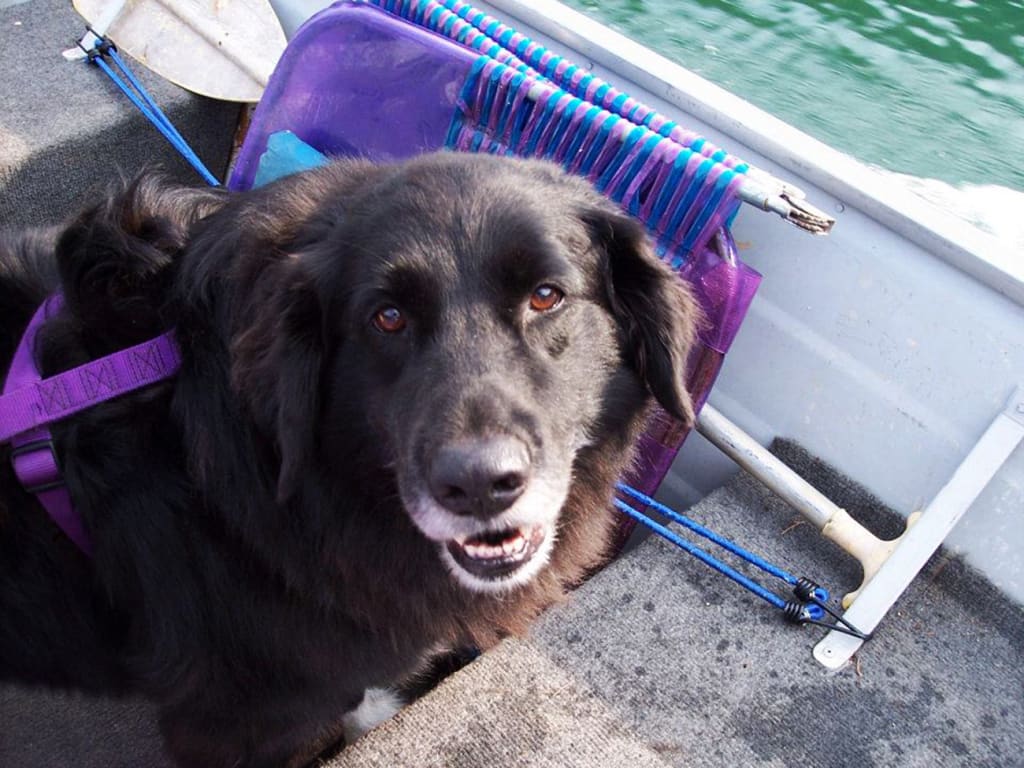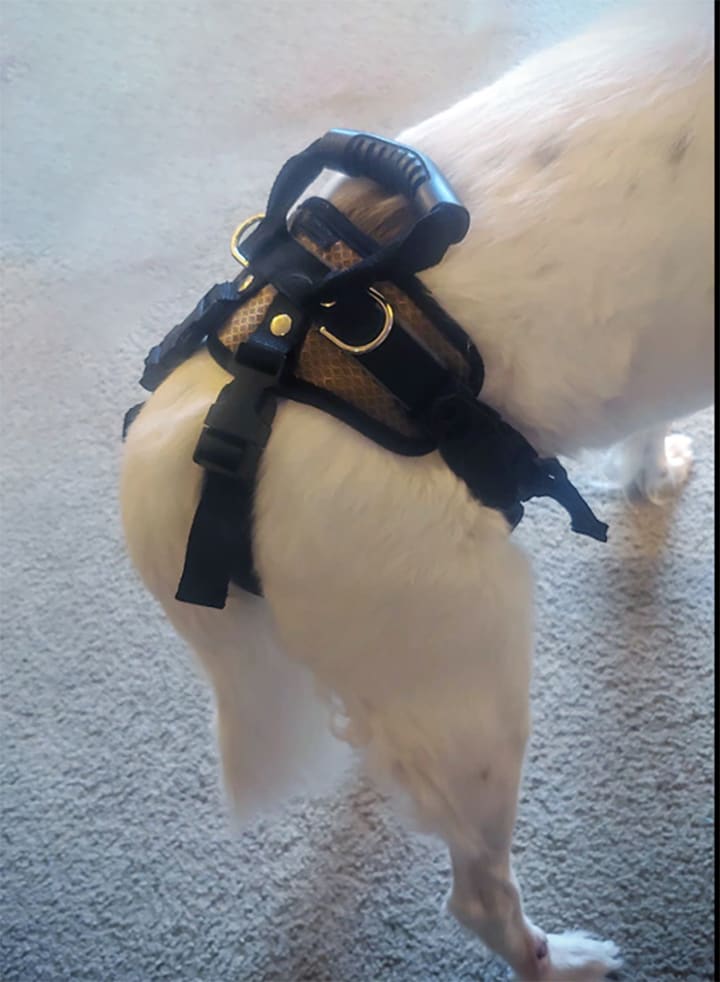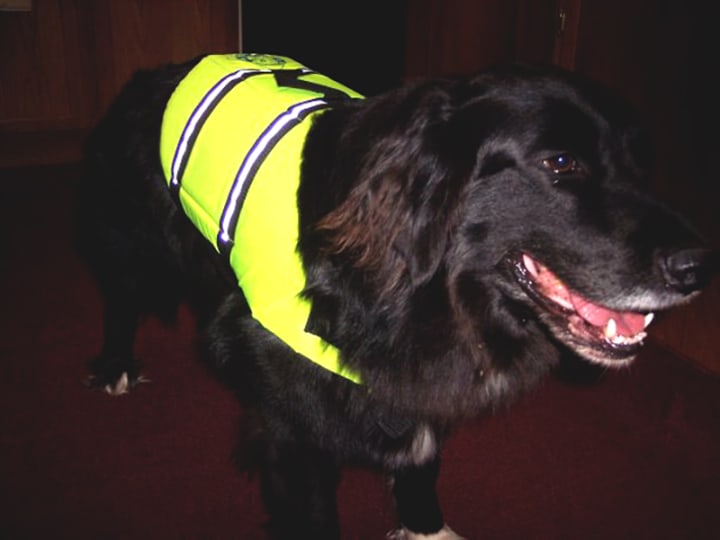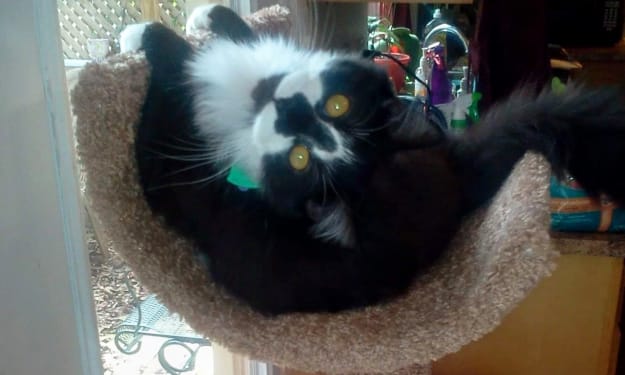My Dog's Temporary Paralysis
Fibrocartilaginous Embolism - What it is and What You Can Do to Help

The Day it Happened
Jasper was a happy, healthy, black lab/Newfoundland mix who loved to swim. His size fell between the two breeds, at about 80 lbs. He had an adorable floppy eared face, medium long fur, soulful brown eyes, and a big, booming bark that seemed to surprise even he, himself, on the rare occasion it escaped.
He would bark and then look around, startled, “Who said that?”, before his face would break into a doggy grin, and his frond-like tail would wag.
As I tended my flower garden one day, while Jasper was chased butterflies and romped about, out of the corner of my eye I saw him take a running leap over a log, all four legs extended.
He suddenly yelped and tumbled to the ground.
I rushed over to see what had happened, and he seemed dazed, lying unmoving where he had landed, panting shallow breaths. I ran my hands over him and he didn’t flinch, just licked at my fingers and whined.
I called the vet immediately and they were expecting us when we pulled into the parking lot. During the entire ride, Jasper had lain frighteningly still in the cargo area of my vehicle. I was beside myself, terrified that he was dying.
As the vet assistants hoisted him out of the SUV, he moved a little, just the upper half of his body, and I tried to keep my tone calm and even, letting him know I was right there beside him.
I had no idea what had happened. One minute he was running through the yard, the next minute he was partially paralyzed.
---
The Diagnosis
It was a fibrocartilaginous embolism of the spine. Commonly referred to as an FCE, or “spinal stroke”, it happens when a bit of the jelly-like, shock-absorbing material of the spinal disc, the “nucleus pulposus”, somehow enters the arterial system and winds up blocking a blood vessel that supplies the spinal cord.
The bit of the spinal cord that is affected actually dies, leading to paralysis. No one is clear on how the nucleus pulposus becomes loose to begin with, as most dog owners (myself included) have no indication of any trauma leading up to the event.
As the vet explained to me that this was the most likely diagnosis of Jasper’s sudden hindquarter paralysis, I was dumbfounded, staring at him in shock. How could this happen to a robustly healthy, three year old dog?
----
FCE Statistics
- usually affects large or giant breed dogs
- affects more males than females
- usually occurs in dogs between 3 - 5 years of age
- after an initial sharp pain, dogs do not indicate ongoing acute discomfort
- often affects only the hindquarters
- often affects one side more than the other
- 75% of dogs recover to some degree
- an FCE is unlikely to recur
As I listened to my vet list these statistics, I really only focused on two things. One, Jasper was no longer feeling severe pain, thank goodness, and two, there was a very good chance he would recover…to some degree.
But first, though my vet seemed pretty sure that Jasper had suffered an FCE, he wanted to schedule him for an MRI, the best diagnostic tool for this type of injury.
The tests are expensive, at that time costing about $3000, but I just gulped and handed over my credit card. This was my baby, my best friend. Cost was not my biggest concern.
After the MRI, they let me see Jasper, though he was pretty out of it from general anesthesia. I whispered to him and petted his head, cringing at the shaved area on his furry back.
I promised him we’d get through this together.
---
Road to Recovery
There is no guarantee that a dog will recover from paralysis after an FCE, but the chances for improved function are very good.
Recovery happens when the spinal cord receives new blood supply from the surrounding blood vessels. As my vet explained it, the arterial network simply branches out, growing over the dead area and closing the gap. This can take six weeks or more for substantial improvement, with a slower progression after that.
If a dog doesn’t show any signs of improvement in the first two to three weeks, chances are slim that any recovery will be made. I received this news soberly, bracing myself for the worst.
When I first brought Jasper home, he was unable to move anything from his mid-back down. I made him comfortable on blankets on the floor, keeping an eagle eye on him for signs of discomfort.
I slept on the couch to be near him, and brought water and food to him every few hours, holding the dishes to his mouth. I turned him over at recommended intervals, as instructed by the vet.
A dog suffering from FCE paralysis may be incontinent for a time. Although bowel functions seemed to happen automatically, I was warned that I may have to manually express Jasper’s bladder, to safeguard against bladder infection. I did have to, but thankfully, it was only a matter of days before he started urinating on his own.
Throughout the first week I was very concerned about Jasper’s state of mind. He was so unhappy. It broke my heart.
I think he understood that I was doing my best, but I could just see the depression, plain on his face. I was careful not to weep when I was near him, but I did have to go outside a few times to sob my eyes out.
I thought part of his depression might be linked to being indoors all day.
I erected a screen house and started carrying him outside to lay on the grass within it. This way, as we sat together, he wouldn’t be bothered by bugs (which he could not flick his tail at), nor get overheated by the sun.
I noticed an immediate improvement in his mood, as he lay with his face in the grass, lifting his nose to sniff the air. I even caught him smiling once! It was definitely worth the struggle of lifting his 80 lb. body to carry outside.
---
How You Can Encourage a Swift Recovery
- Stretching and Exercise - It’s very important to maintain the flexibility and muscle tone of a dog who is paralyzed, whether temporary or not. The vet offered some general instruction on stretching exercises, and I found out more through research.
Jasper seemed happy when I manipulated his limbs, bestowing a doggy grin upon me. When he was happy, I was happy.
- Massage - Massage is beneficial, as well. Manual stimulation of the muscles will encourage much needed circulation in that area.
I had just finished exercising Jasper’s back legs one afternoon, at day 12 after the incident. I would talk silly to him while I tended to these tasks, trying to keep up his spirits.
I finished the session by holding up his tail and giving it a mini-wag, while cooing, “Good Boy!” And then it happened.
As he grinned at me, tongue lolling, his furry tail wagged on it’s own! I was so happy I cried and hugged him and then called his vet. It was the first sign he was going to recover.
Recovery sped up after that. Within a few days, Jasper’s left foot would twitch a bit, then his left leg. We visited the vet and they decided it was time to try walking him with a harness, even though his right leg was still paralyzed.
- Back End Harness - Special harnesses are available for situations when a dog is unable to support their hindquarters, either due to age or injury.
I found a company that would custom make a harness for Jasper, using measurements I took. The back legs fit through loops, there was an opening beneath the tail (for obvious reasons), and there was a sturdy grip above the lower back. The company I used is no longer in business, but here’s a picture of the same harness on a friend’s dog (who suffered from age-related hip problems).

To use a back end harness in early FCE rehabilitation, the owner lifts the hindquarters totally off the ground as the dog propels himself forward with his front legs only.
The vet warned me that Jasper would probably try to use his back legs and kick his feet. Gradually, over time, I was lower his hindquarters a little bit, letting him come in contact with the ground, and eventually let him support some of his own weight for short periods of time, always maintaining a grip on the handle in case he floundered.
It’s important to not go too fast. The “patients” are not the best judge of what they’re able to do. Just because the dog wants to walk, doesn’t mean you should let him.
- Booties - It’s quite likely when the dog begins to walk again, he’ll still have some difficulty. Jasper was unable to completely flip his paws back up after a downswing, resulting in him walking on his knuckles. Protective booties are a must, as the skin on the top surface of the foot is very thin and can be easily injured.
There are many companies that sell these booties (look on Amazon), and they are made in a range of materials, from cotton fleece to canvas to neoprene. Some have ultra grippy rubber bottoms to keep dogs from slipping.
I tried several on Jasper, and he seemed to be most comfortable with a plain heavy canvas-type material, with a velcro strap to secure around the ankle.
Jasper wore a boot on his right foot whenever he was outside, for the rest of his days. He became so accustomed to it, he would automatically lift his foot for me to put on his boot when waiting at the door.
- Swimming - Swimming is an excellent therapeutic activity, strengthening the muscles without putting weight on the weak limb(s).
Fortunately, swimming was something Jasper adored! I bought him a life jacket with a handle on the top, and would take him to the lake and support him while he swam. He loved it! (I don’t think he ever knew I was holding him up)

---
Jasper’s Happy Ending
Jasper was lucky. He was one of the 75% that recovers substantial mobility after an FCE.
About eight weeks in, he was adapting his gait, his left leg was almost normal, except when he was tired. His right leg improved slowly, but he always walked with a limp (more of a “skip” when he was excited), and he continued to wear a boot.
In six months time, Jasper was recovered enough to go camping, another of his favorite activities. He lived a long and happy life, eventually succumbing to old age at fourteen, without another serious health crisis.
I was blessed to call him my friend, and I miss him still!
About the Creator
Shell St. James
Shell St. James is a New England author living in an 1895 farmhouse with her musician soulmate, feline muse, and a benevolent ghost. Her novel, "The Mermaid of Agawam Bay", is available on Amazon. Find out more at www.shellstjames.com






Comments
There are no comments for this story
Be the first to respond and start the conversation.